Picross 2 Review Rewind
|
|
See PixlBit's Review Policies

On 10/10/2011 at 11:39 AM by Chessa DiMola It may not be perfect, but it's a shame this unique Picross game never made its way to America. |

A must import for Picross fans.
Picross is hands-down my favorite pick-up-and-play puzzle title of all time. I've played nearly every game based on nonograms I could get my hands on, including flash ones online. However, due to being Japan only releases, there were two big Picross titles that eluded me for a while, Picross 2 and Mario's Super Picross. After scouring eBay for an available copy of either title I was delighted to see that both games were relatively inexpensive as far as imports go and impulsively purchased them both. After their very long journey to my house across thousands of miles it was only right to play them immediately, and since Picross 2 arrived first, it received the honor of the first playthrough.
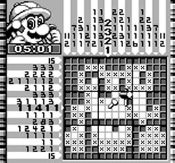
Upon booting it up for the very first time, I was immediately caught off guard by the presentation. Unlike the overwhelming majority of other nonogram games, Picross 2 doesn't organize its puzzles by challenge level and level number. Instead, Picross 2 ties the puzzle solving experience into a very shallow story in which Mario is an archaeologist of sorts and goes around deciphering these puzzles in different locations. That of course is an absolute assumption since I don't know how to read Japanese, but all the clues point to that being the most probable conclusion.
Each of these locations, of which there are ten in total, contain ten puzzles of their own. The majority of puzzles can be solved in any order players wish with the exception of the tenth, which will only appear after the other nine have been completely solved.
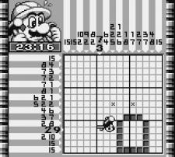
The biggest element that separates Picross 2 from other Picross titles is the size of the puzzles being solved. Most Picross puzzles are solved on a 15X15 grid in one shot, however the puzzles in Picross 2 are 30X30 and are solved in four 15X15 sections. Players have one hour to complete the entire puzzle but can lose points by filling in wrong tiles or by asking for hints.
When I first started playing through Picross 2, I was pretty impressed with the unique twist that solving a puzzle in chunks brought to the table. After all, it provided the core puzzle solving elements of Picross alongside a brand new puzzle structure. Not to mention that the resulting pictures were way more interesting than the simpler images usually uncovered in a traditional 15X15 puzzle. But while the giant puzzles were entertaining for a while, eventually they became too much, for several reasons.
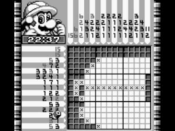
First, they took a bit too long to complete entirely, for a puzzle game that is. After obsessing over the series for many years at this point, I think it's fair to say that I'm pretty damn good at Picross. So for me, each puzzle took between ten to twenty minutes to complete; far longer than I have ever spent completing a traditional Picross puzzle. Now I'm not necessarily complaining that the puzzle shouldn't be that long, just that a puzzle game is meant to be more easy to pick-up-and-play than the average title. So, when puzzles last twenty minutes I wind up feeling bored and impatient rather than satisfied or accomplished at the end of it all. Thankfully the game allows mid-level saves, so I was able to save my progress when an obligation presented itself, though ending in the middle of a puzzle was even more dissatisfying.
The second thing that disappointed me a bit about Picross 2 was not always being able to tell what I was creating until I had already spent time filling in two or three 15X15 grids. One of the things that always kept me intrigued with other Picross titles was the ability to distinguish the image I was filling in as I was solving the puzzle. In Picross 2, the majority of time spent solving the puzzle felt like filling in a randomly generated puzzle whose blocks were arbitrarily selected.
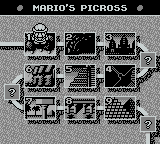
But, like I already stated, when the image does come together, it is much more spectacular than anything featured in the other games. The problem with this in my eyes is that, without the smaller standard puzzles with more mundane results, the grandness loses its affect. If each world featured a few standard 15X15 puzzles with solutions like palm trees or planes, uncovering King Tutankhamen would have felt far more satisfying.
Actually, I have to admit that there are SOME small puzzles in the game, however they're in the form of odd speed challenges that just feel out of place. After passing every few worlds players will encounter a level marked with a “?” in which they must solve a fair amount of puzzles within a short amount of time. The problem with these is that the puzzles are on a small grid, the images are random, and they are repeated fairly consistently. Every time I hit one of these levels I rolled my eyes, sighed, and begrudgingly got through it as quickly as possible.
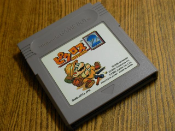
Picross 2's biggest downfall is that it just isn't particularly challenging. Neither the Mario or Wario mode offers up any trial that I would consider to be difficult. Oh, did I forget to mention there were two separate modes? Silly me. Well then, to put it as concisely as possible, the two modes are practically identical, except players are not informed of their mistakes in Wario's puzzles. Also, since players don't know when they are filling in wrong squares, they can't be penalized for wrong answers, thus they are given half the time to solve a puzzle. I had a ton of fun with Wario mode, mostly because I knew that one mistake could cause me a lot of problems in the long run so I had to be really careful and precise.
After I played through every puzzle in every world in either Mario or Wario mode, I unlocked a gigantic Picross puzzle. The final puzzle for each mode is 60X60 and is split into four 30X30 sections, which are each played like a typical level in Picross 2. The only difference is that I was given less time than usual to solve each of the quadrants, but thanks to quick saves and the puzzle just not being very difficult, this wasn't that big of a deal.
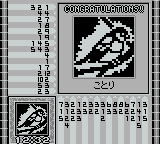
Even though Picross 2 was really easy and I was a bit unhappy with the puzzle size for several reasons, it's a really great Picross game and has a lot of content. While it technically only has 202 individual puzzles, there's really 800+ when you break everything down into a typical sized 15X15 Picross puzzle. That's a lot puzzles. Even better for Picross fanatics is that Picross 2 doesn't really cost that much, going for an average of about fifteen dollars with shipping on eBay.
I can nitpick this game all day long but the bottom line is I've been glued to it for nearly two months at this point and I'm only almost done with Wario mode. It's the most original Picross title I've played next to Picross 3D and should be a necessary title in any Picross enthusiasts collection.







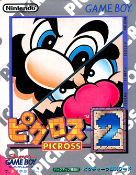


Comments